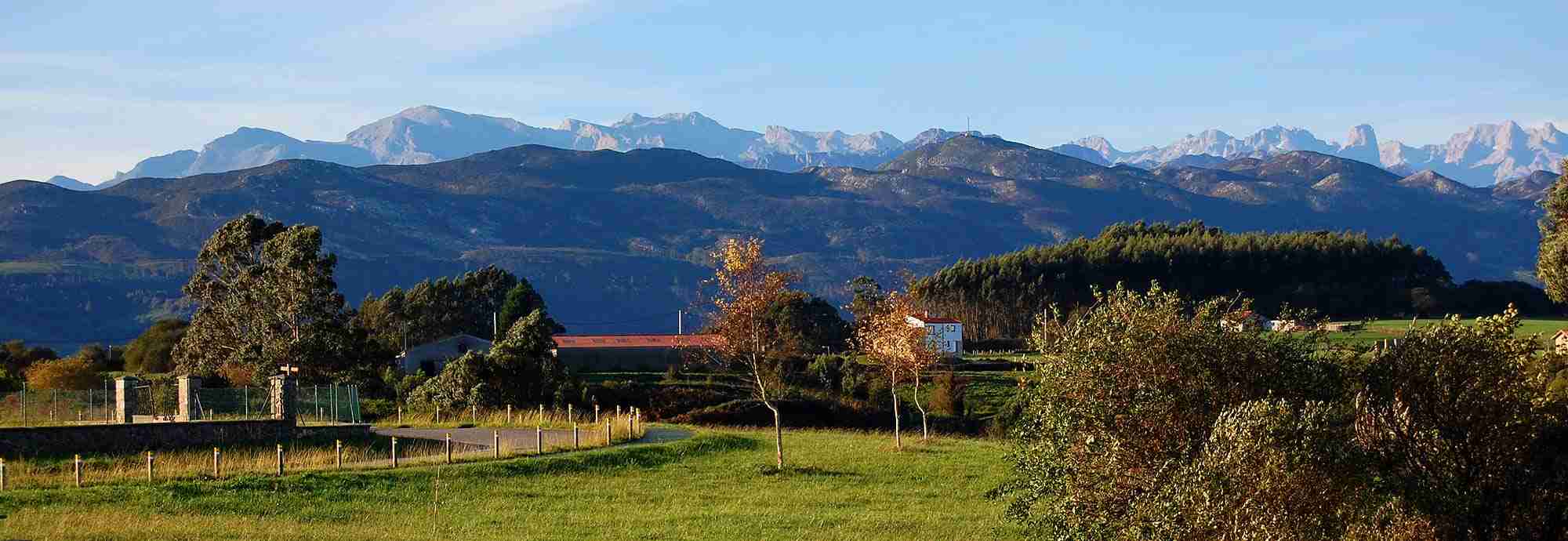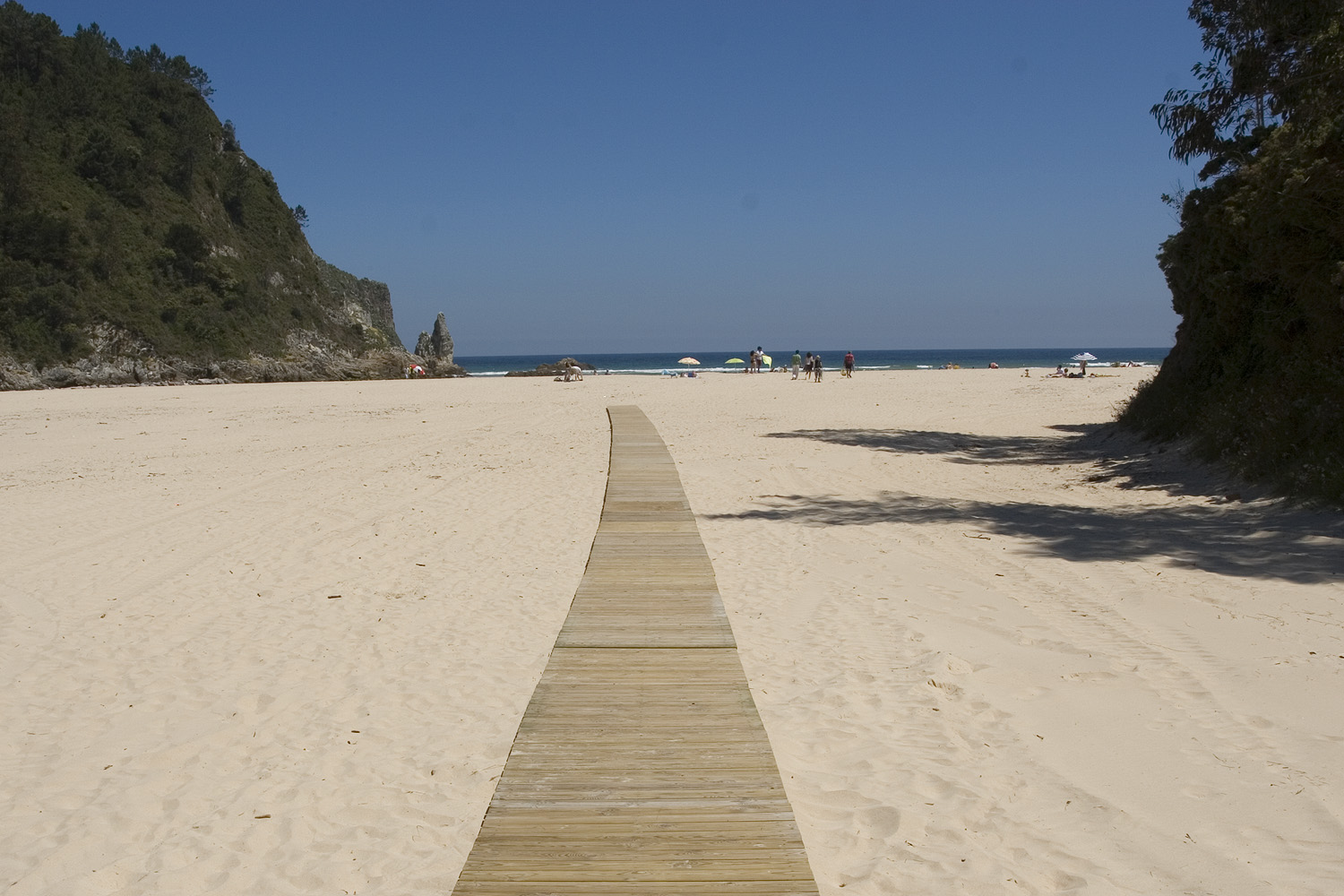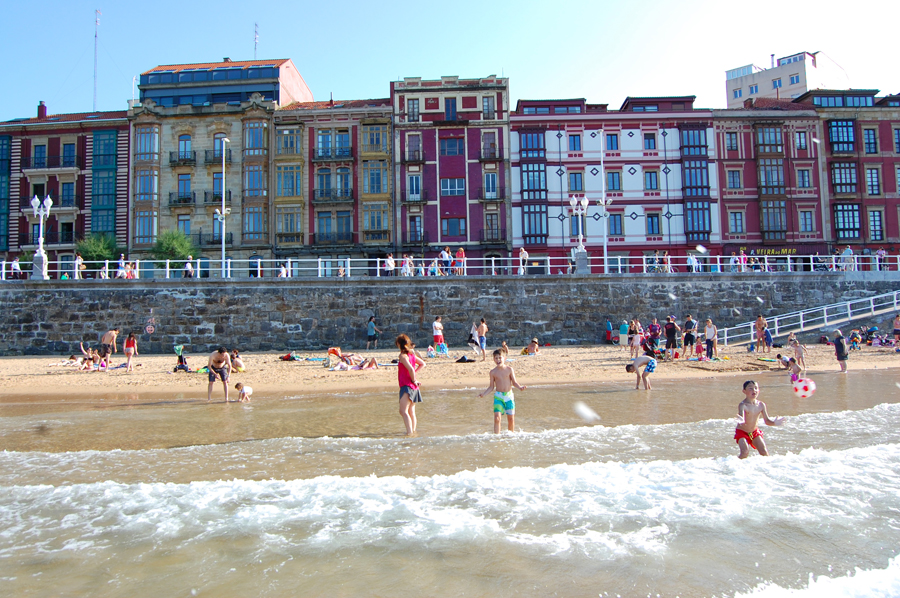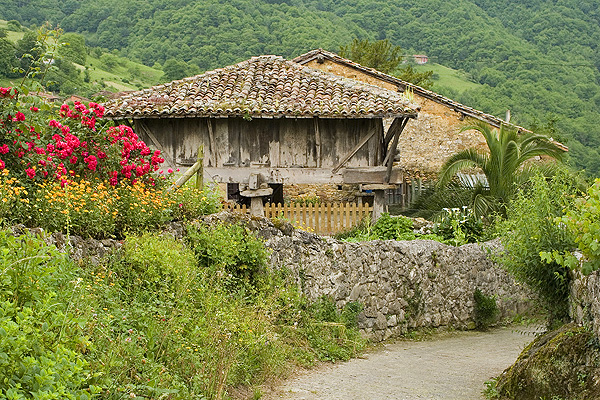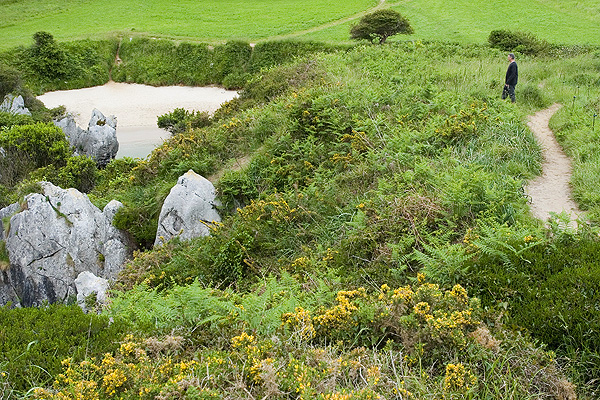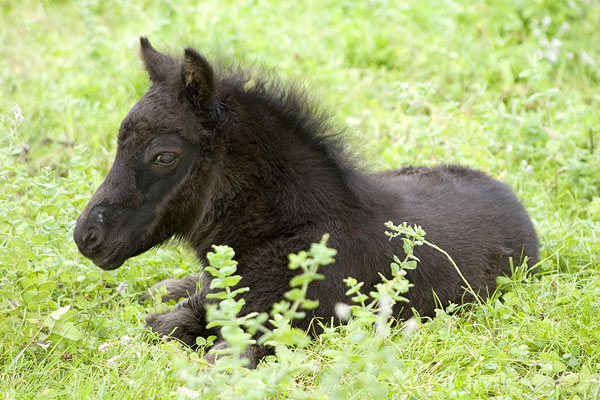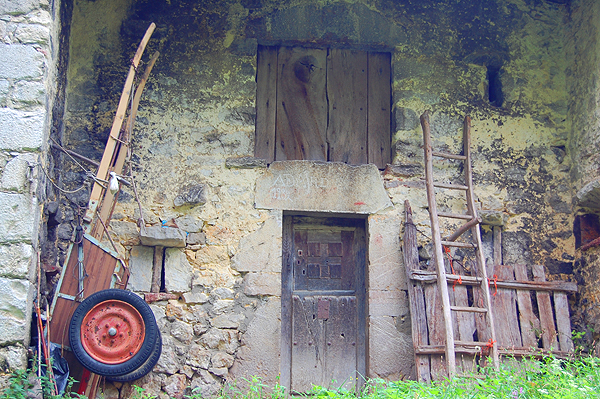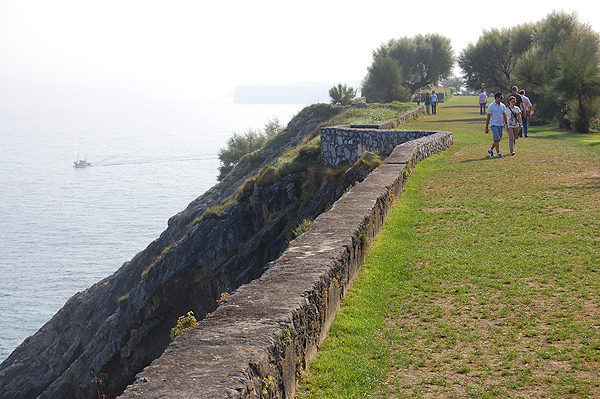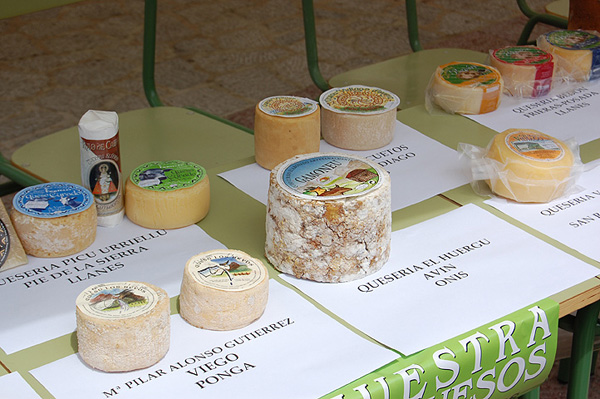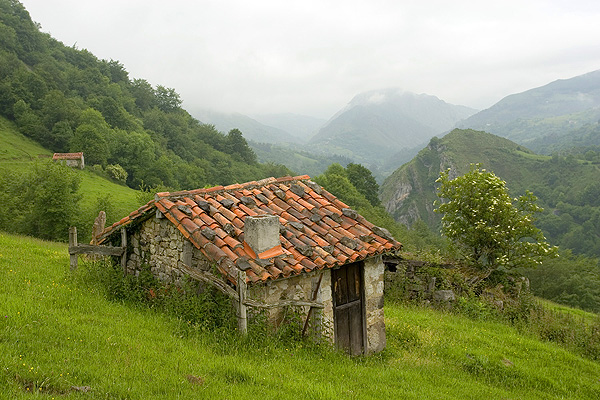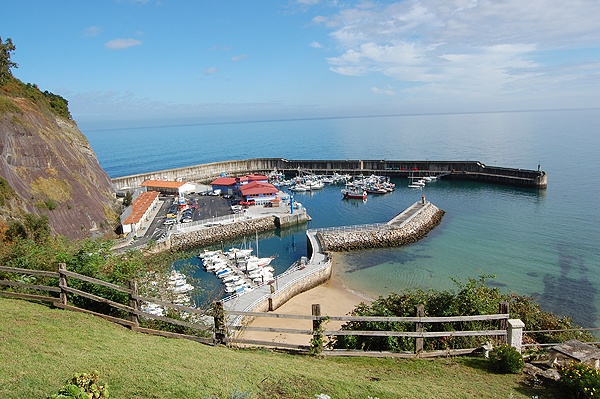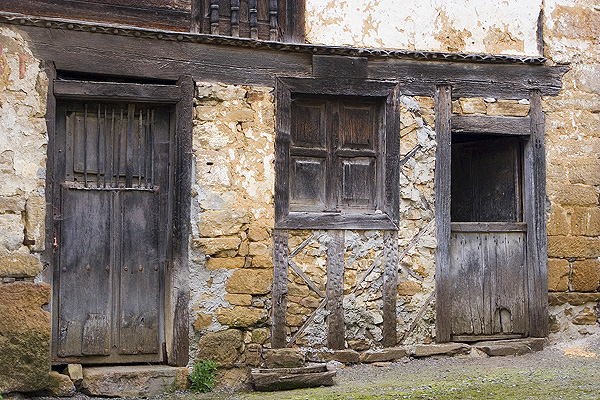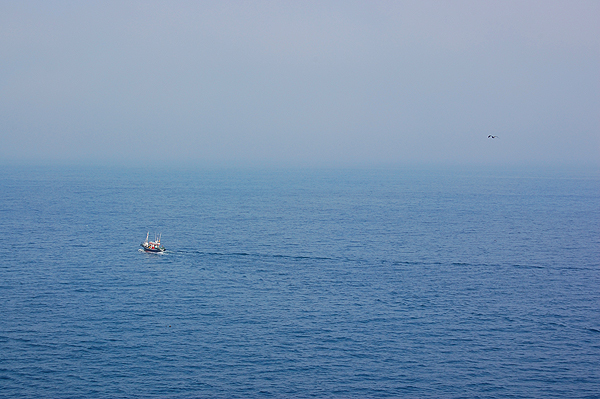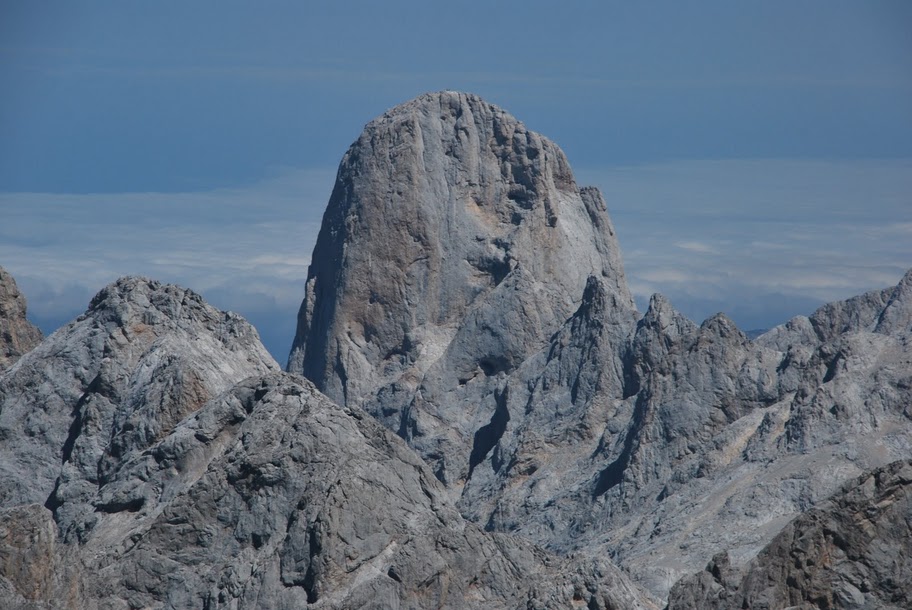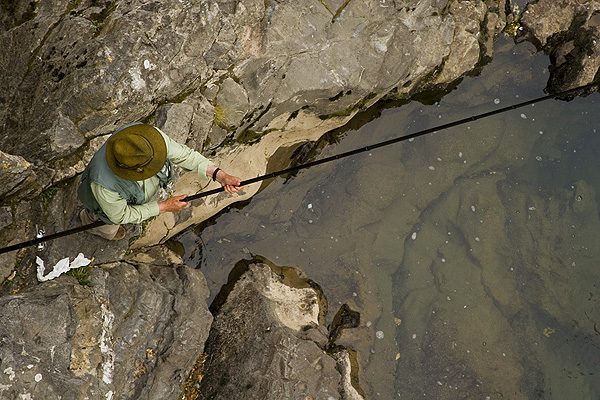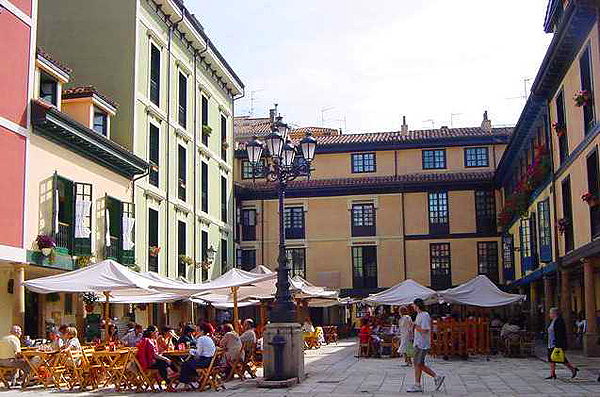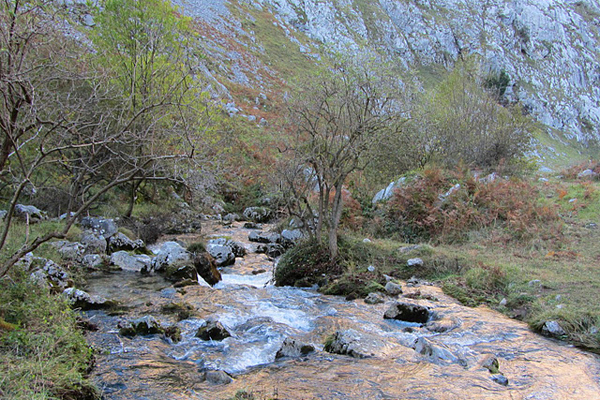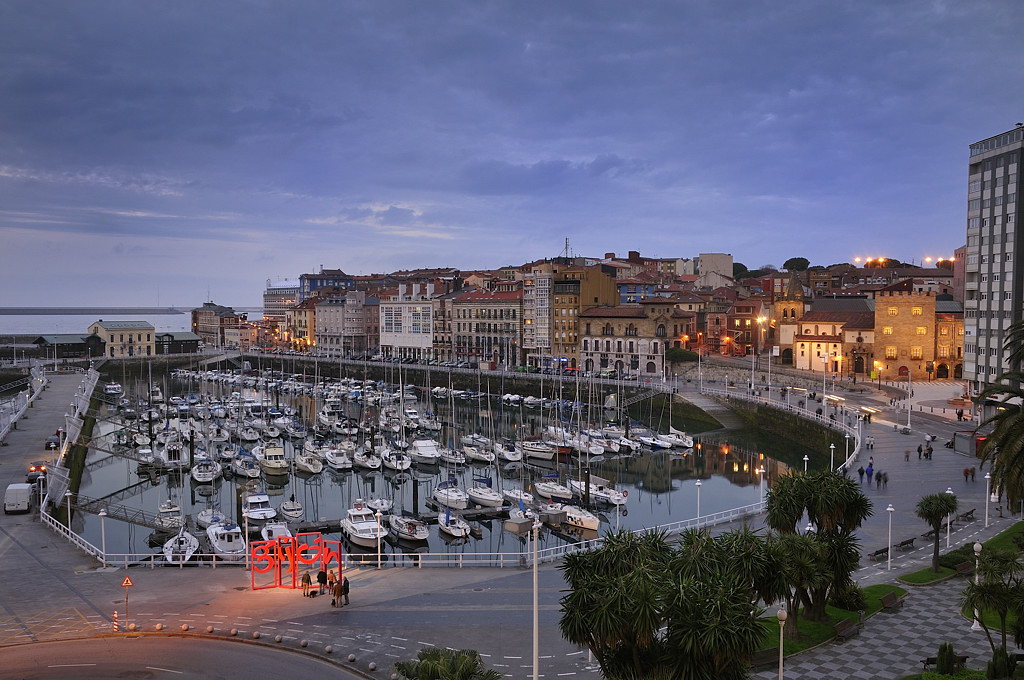The magnificent mountain range is what come to the mind of most Spanish people when Asturias is mentioned. The Picos de Europa are a National Park which nevertheless has a few little villages within its boundaries that coexist harmoniously with the protected environment. Conjoined to high, jagged peaks, the serrated ridges of its snowy massifs sweep down to elm, beech and Pyrenean oak woodland in valleys, to hay meadows alive with wild orchids.
The route into the Picos enters via Cangas de Onis, which buzzes with activity agencies, and the first stop tends to be Covadonga, where the views are already astonishing.
The Cave at Covadonga, known as the Holy Cave, has a Sanctuary is dedicated to the Virgin Mary and the tomb of King Pelayo. It was Pelayo's victory over the Moors at the Battle of Covadonga in 722 AD that set the Christians on their way to the reconquest of Spain, and so the spot has a distinct historical resonance.
A waterfall gushes down from directly beneath the cave. From here, the winding route up to the Covadonga Lakes takes some beating for sheer natural spectacle. Cyclists may be already familiar with this 12 km climb – a testing stage in the Vuelta de España road race – the rest of us will probably prefer to drive it. You reach Lake Enol at 1,070 m to find horses and cattle grazing the high pastures; higher still at 1,108 m, Lake Ercina's glacial waters shimmer in changing shades of colour.
CARES DEFILE WALK & FUNICULAR RAILWAY TO BULNES
The "classic" hike in the heart of the Picos and the ride up to Bulnes village at the base of Naranjo de Bulnes mountain both start at Poncebos. They are described more fully as Main attractions in our Picos de Europa Holiday Guide.
SIERRA DEL SUEVE
The hills and mountains of Sierra del Sueve are close enough to the sea for mists to sometimes rise there and shroud the beech woods and ancient yews with an otherworldly aspect. Ramble the trails of Sueve, these hills by the sea, and you enter into another little world. It is marvellously mysterious when the sea mists roll around the green mountain landscape! It is also home an equine treasure which you are very likely to see the unique asturcón horse.
Pico del Pienzu here is one of the closest mountain peaks to the sea in the world: just 5 km separate the summit from the Atlantic. The views from the top are tremendous. You can see a variety of animal life including not only the fascinating asturcón but also vultures, roe deer and (at a distance and very rarely) wolves.
In the Local Guide that we send to holidaymakers, walks in Sierra del Sueve and many more holiday ideas are set out in detail.
CIDER COUNTRY (PILOÑA)
Comprising most of the inland region south of Sierra del Sueve and traversed by the N-634 road that runs from Nava, home to the Cider Museum, in the west to Arriondas in the east, Piloña is a beautifully unspoilt area comprising 24 parishes.
It's also the main cider area, where Asturias's best-known drink is produced and enjoyed with a ritual pouring. You'll find a sidrería (cider house) in most villages of any size. Sidra is important in local culture; find out more in our article: Of cider and cheese.
Cider Country (Piloña) is more like a shire, enchanting to walk and explore. Country lanes follow trout-filled rivers though gorges and wind through wonderfully preserved villages of old stone cottages, valleys with views of the Picos de Europa, traditional homesteads and ecclesiastical architecture, mossy country homes and woods of beech, chestnut and oak where edible mushrooms sprout. The hills have abundant populations of deer and wild boar.
ESPINAREDO
Little Espinaredo in Cider Country is reached by following the rushing, trout-filled River Infierno up its winding valley, with mountains all around. In this enchanting location, one half expects one of Asturia's legendary duendes, (elves or goblins), to step out from behind a tree or river boulder. Among the old houses are hórreos – pillared granaries – some of which date back to the 16th century.
BOATING ON THE RIVER SELLA AT ARRIONDAS
At the small town of Arriondas, the River Sella is swelled by the Piloña river, making it a big draw for the number of small operators offering downriver canoe and kayak trips. It has become such a popular activity that you'll have no problem hiring a boat if you want to try it. In August, people come from far and wide to take part in the festive International Canoe Race, which is accompanied by music and street events.
NIEMEYER CENTRE
The International Cultural Centre designed by Brazilian architect, Oscar Niemeyer, was inaugurated in 2011. After being temporarily closed due to political disagreement, it is open again and starting to find its feet as a major reference in the cultural world. It's situated at Avilés, close to Asturias Airport, where it represents the showpiece of a large-scale scheme to regenerate the Avilés waterfront.
ASTURIAS BEACHES AND FISHING VILLAGES
There are a significant number of these and they include some of the best beaches in Northern Spain, are strung out along what is popularly known as the Dinosaur Coast, owing to the impressive fossil record found here, including fossilized dinosaur footprints. There are also attractive towns with harbours and seaside villages.
Rodiles beach, backed by pine forest, is deservedly well-known but there are plenty more options, in thrillingly natural settings. To guide you, we publish an online guide to some of the very best Asturias beaches that we have searched out and photographed.
LLANES AND BICYCLE HIRE
At this elegant and lively fishing village where you can enjoy strolls along the cliffs, the riverside or the harbour to the lighthouse, past Basque sculptor Agustín Ibarrola's Cubes of Memory, and then dine excellently at a choice of bars and restaurants along the cobbled streets of the old town.Very close to Llanes FEVE railway station is a bicycle hire shop. You can cycle along a track as far as Poo, on the outskirts of Llanes to the west. From Poo, a signposted single-lane path continues along the coast for about 15 km.
Also in Llanes is an activity agency called Torimbia Ocio Natural. As well as bicycle hire, they offer other activities like horseriding, hot-air balloon flights, canyoning and much more. You can check these by visiting their website torimbiaocionatural.es
LASTRES
One of the nicest of the seaside towns, Lastres has its own beach, a fishing harbour and great views out over the sea.
JURASSIC MUSEUM
Close enough to be visible from Lastres, the museo jurásico is a huge hit with children. Mock-up dinosaurs here can then be followed up by going down to La Griega beach, which the museum overlooks, to search for dinosaur footprints: they really are there, fossilized in the stone. Going back some 65 million years, dinosaur footprints are to be found all along the coastline between Ribadesella and the historical city of Gijón, Asturia's main port.
TAZONES
Diminutive Tazones, near Lastres, nestles under high cliffs and is very popular with day trippers who descend on its restaurants for fish and seafood lunches. We found it to be curious to stay a while, but rather busy and overpriced.
NATURAL PARKS OF PONGA AND REDES
While the Picos de Europa are Asturias' high point and the only National Park, there are several Natural Parks that provide exceptional walking and touring opportunities.
Ponga
To get completely off the beaten track, you have only to take the road south into Ponga, where ravine, mountain and impenetrable forest are overwhelming. Drive south on N-625 from Cangas de Onis and discover this wonderful Natural Park.
Redes
This Natural Park borders Cider Country south of Piloña. It's a UNESCO world heritage site where glacier and rain have gorged out a fascinating 377 km² of craggy limestone. There are caves and grasslands in Redes, broad valleys and wooded hillsides. Woodland of beech and white oak covers 40% of a territory whose altitude varies 5,000 feet and whose precious wealth of bird, reptile and animal life cannot be over-emphasized. Local industry comes from the carving of traditional wooden clogs and honey production.
BEARS
The endangered brown bear is zealously protected by the Asturian principality, although occasionally hunted photographically by certain tourist companies whose 4 x 4 vehicles only disturb their habitat. The bears are respected by the locals, for whom they represent a link with their history and patria, or homeland.
BEST OF THE REST
Nava Cider Museum
The town has 17th century churches and La Cogolla Palace to its name, yet its best-known landmark is the Cider Museum. Open every day except Monday. It's the perfect place to learn all about Asturias' emblematic drink, which you can also read about in a Rustical Travel article Of cider and cheese.
People of the Picos
The Picos de Europa mountains are thrillingly beautiful and doubly interesting for being a National Park with habitations: there are several hamlets and villages which coexist in successful harmony with the protected alpine landscapes.
Indianos Museum
In Colombres, you can learn about how the Asturian emigrants who made their fortune in South America came back to build proud homes. Housed in one of the most striking of these, the Indianos Museum tells the story of these adventurers. Some of those who made it and returned built impressive family houses. Often fronted by the palm trees that reminded them of Argentina and similar destinations, these stand out even today among the humbler neighbouring houses in villages along the northern coast.
Peña Tú
At Puertas de Vidiago, 12 km from Llanes, is the sandstone idol called Peña Tú. Here you can see prehistoric paintings and engravings. No fewer than fifty ancient burial grounds have so far been discovered here at the Sierra de Borbolla.
Take the train to the coast
Asturias has a good, reliable and inexpensive light railway system (FEVE), a nice change from the roads that allows your driver to take a day off. You can take the Feve to seaside Llanes, for example: highly recommended. Other options include the very pleasant coastal town of Gijón, or Ribadesella, a busier town with its own beach (a good walk from the station so pack light).
Other wildlife and birdlife
Asturias is home to a vast wealth of wildlife, not just bears. There are a few wolves, and plenty of chamois and roe deer, wild boar and foxes. In the woods live partridges, mountain cats, the black woodpecker, the dormouse, squirrels and genets. A few capercaillie still survive in the Asturian Picos.
More than a hundred varieties of birds inhabit the mountains and valleys. star attractions are the raptors: Golden Eagle, Short-toed Snake Eagle, Egytian Vulture, Griffin Vulture and Bearded Vulture. You can also spot Red-billed and Alpine Choughs, the Dunnock, and Pipit.
Birders will be delighted to know that spotting trips are a speciality of English-speaking ornithologist Javier Gil.
Fishing
For approximately 13 euros, EU citizens can obtain a tourist fishing permit from the Asturias government via its website
Markets and Fairs
For shopping or simply an interesting insight into the local culture, here are some markets and fairs you may wish to visit (generally mornings until 2 pm):
Weekly markets
Infiesto: Mondays
Villaviciosa: Wednesdays
Bimenes: every second Thursday
Colunga: Thursdays
Nava: Saturdays
Cangas de Onis: Sundays
Oviedo: Sundays
Craft fairs
Cider Country, Villaviciosa: Easter
Traditional craft & foods, Nos Alcuentros, Colunga: July
Traditional crafts fair with music and activities for children, Mercau Astur, Ceceda, Nava: end of July
Traditional crafts fair of Oles, Villaviciosa: early August
You will also find a host of cattle markets and local fairs throughout the year.
Oviedo
Asturias' interesting and cultured capital with its pre-Romanic monuments and cathedral, makes a change from the rural splendour. Oviedo is the home town of Asturias's most famous son, Fernando Alonso.
FOOD AND DRINK
Asturias has a tradition for hearty eating that only mountain folk could maintain. Only light eaters and vegetarians might find it a challenge. Expect tasty, hot and generous servings.
Fabada is a slowly cooked, rich stew based on a special white bean and flavoured with pork, chorizo, black pudding and saffron. Beef and lamb generally come from animals that have fed on the green and healthy Asturian pastures. With the sea never far away, the local gastronomy also includes fish and seafood.
Light, dry Asturian cider is a culture all to itself, requiring a skilled decanting from above head height into the glass to aerate and lend it its full fresh tastiness.
Asturian cider, lighter and less alcoholic than its English Somerset counterpart, is drunk with meals, with relish, and at the drop of a hat. Much more than just a drink to the Asturians, it has its own ritual pouring on which depends both its taste and its power to refresh. Cider is the beverage par excellence in Asturias and you'll soon see how much is a essential element of the culture when you see friends a sharing a bottle or two, decanting it in a brief cascade from above shoulder height, not out of bravado, but to give it its live and zesty taste.
Cider is typically enjoyed at a cider bar (sidrería) but also in restaurants and you can also visit cider factories where apples are pressed and fermented in giant vats. Examples of cider factories are:
• El Gaitero in La Espuncia just north of Villaviciosa.
• Sidra Cortina just south of Villaviciosa.
• Sidra Crespo in Sales, west of Colunga.
Cangas produces its own wine but quite frankly it's not a shade on Spain's major reds such as La Rioja, Ribeira de Duero, Priorato or the whites of neighbouring Galicia, which you'll find on the wine list at any decent restaurant.
Sidra is classically accompanied by the local Cabrales cheese, spicy and creamy. Cabrales isn't the only cheese: Gamonedo is also excellent.
Another local delicacy is Cecina: air-cured smoky beef.
Espinaredo
We have been recommended:
• Mesón Vizcares for a very good and inexpensive lunchtime set meal (menú).
Arriondas
There is a varierty of places to eat out from pizza to two Michelin-starred establishments. Our choices:
• La Terraza restaurant - For its quality, setting, atmosphere and price is this excellent restaurant overlooking the river at Hotel Casona del Sella on the town hall square.
• El Corral del Indianu
• Casa Marcial
Lastres
• Bar El Puerto in Lastres harbour (Lastres Puerto is busy and loud in summer, but very Spanish. It has a great choice of fresh fish and seafood (other dishes available).
• El Descanso - Another restaurant we recommend is to be found before you reach Lastres village from La Griega beach, on the right hand side as you drive down to Lastres playa (beach). There is parking space just opposite. Decent prices and good, unpretentious food.
• El Barrigón de Bertín - The classiest of the three, it serves first class fish and seafood in a stylish ambience, with well-chosen Spanish wines. It's on a bend of the main road as you come into Lastres. Best to park by the parish church and walk from there. Look out for a ship's anchor on the bend: the restaurant's just below there.
Niembro & Torimbia beaches
An early evening stroll along Torimbia beach is very nicely followed by dinner at San Pelayo in Niembro, a very smart restaurant with 20 specialities (open Wed-Sat evenings only, book in advance).
Another option in Niembro is El Buzu restaurant. Not a refined establishment like San Pelayo: we love it instead for the authentic experience of a busy, popular restaurant serving excellent fresh fish and seafood at reasonable prices. You can also order a paella at Torimbia chiringuito (beach bar-restaurant) for lunch. Tell them well in advance what time you wish to pick it up and they'll have it ready for you.
